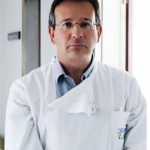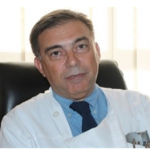The following article makes reference to certain companies and their products and any opinions expressed should not be taken to be the views of Dystonia Europe or its members. The articles are written by respected authors and are provided for the information of Dystonia Europe News readers.
Dystonia is a heterogenous disease, which dramatically affects the lives of patients, their families, and caregivers. Stimulation (DBS) is among the different therapies available to help treat the symptoms of this debilitating condition.
Today, we have the pleasure to interview 2 world leading experts from the University Hospital of Santa Maria, in Lisbon: Professor Gonçalves Ferreira, the head of the functional neurosurgery unit and Professor Miguel Coelho, a movement disorders neurologist.
Professor Ferreira began working in functional neuro-surgery and DBS 25 years ago, though he was with Professor Benabid, considered to be the Father of DBS, in 1987 and 1988 when he first performed the DBS implantation for Parkinson’s Disease patients .
Professor Coelho has been working with dystonic patients for 20 years now, holding a botulinum toxin clinic for about 15 years. Professor Coelho coordinates the DBS program at University Hospital of Santa Maria, which began in 2006. Initially for Parkinson’s disease, but has included dystonia patients since 2010. Professor Coelho is also the president of the Portuguese Society for Movement Disorders, allowing him to develop a unique perspective into dystonia.
Professsor Coelho Professor Ferreira
What do you like about your position, helping Dystonia patients?
Both Profs Coelho and Ferreira: Many dystonic patients go through a long process, seeking consultations in other specialities before they finally reach a neurologist. For us, it is really important to be able to identify which involuntary movement the patient has and understand the cause of it. There are many causes of dystonia; genetic, metabolic, pharmacological, or other neurological disorders that present with dystonia. Until this point many patients have been told there is nothing wrong with them, or the problem was from the neck or spine. So, in that regard, it’s really satisfying to be able to give the patient a diagnosis as it makes them feel more comfortable, because finally, they know what they have, and they have a name for their disorder.
From your experience, what’s the impact of dystonia on patients’ daily lives?
Prof Coelho: Dystonia has a great impact in the daily lives of the patients, mainly affecting their quality of life. It is really disability in their everyday life, but also it causes social embarrassment for them because not a lot of general population are familiar with this disorder. In many cases, such as cervical dystonia, it is also associated with pain in many instances, and in that regard it’s a constant cause of suffering.
Prof Ferreira: It is also important to take in consideration, that this disease will also affect the lives of others close to patients, that it is their family or caregivers, as many dystonia patients require a lot of different care measures.
Prof Coelho: Dystonia has a great impact in the daily lives of the patients, mainly affecting their quality of life. It is really disability in their everyday life, but also it causes social embarrassment for them because not a lot of general population are familiar with this disorder. In many cases, such as cervical dystonia, it is also associated with pain in many instances, and in that regard it’s a constant cause of suffering.
Prof Ferreira: It is also important to take in consideration, that this disease will also affect the lives of others close to patients, that it is their family or caregivers, as many dystonia patients require a lot of different care measures.
What are the different therapies available for patients with Dystonia?
Prof Coelho: Initial treatment with botulinum toxin provides very good outcome in patients with focal dystonia. If they don’t improve significantly with botulinum toxin, they become resistant to it, or they can’t achieve a reasonable benefit, they should discuss the possibility of undergoing DBS with their physician or with their neurologist.
How does DBS works and how can it help with the symptoms of dystonia?
Prof Coelho: DBS is very effective and very efficacious in treating dystonia. Many studies found an improvement of 50% to 75% increase in the quality of life for patients undergoing DBS, which is an excellent result.
Prof Ferreira: Therapy, as in other movement disorders, does not treat the cause of the disorder, but it inter-feres very well with the mechanisms that produce the major symptoms of the disorder. So, we interfere with high-frequency DBS, which means that usually it affects the structures where it is applied. It’s essentially inhibitory.
We mainly induce this electrical inhibition in the Globus Pallidus pars Interna (GPI) because it’s the best target. We manage to interfere and to diminish the dysfunction, essentially among the basal ganglia of the cerebral brain, and the symptoms are often improved.
In some patients we have a very good response to DBS, although dystonia is quite a different disorder to, Parkinson’s disease, in which results are more homogenous and uniform, and therefore more reliable. However, dystonia is not a disease, it is a set of many different kind of disorders and so, we have rather different results with primary dystonia and secondary dystonia’s, with the latter generally seeing poorer results.
Many patients appear in neurosurgery already at an advanced stage in the disorder and I think we should make an effort, all of us, to treat them earlier and earlier, because the results are usually better.
Following DBS will patients resume some form of normal life or improve their quality of life?
Prof Ferreira: Their quality of life can change quite a lot. It does however depend on the clinical presentation of the specific disorder, which has led to their dystonia. When we inform the patients and their families about the prognosis for the future, we must be cautious because, in primary dystonia, we have a very good result in about a half to two thirds of patients. On the other hand, for the secondary dystonia’s, it varies quite a lot. We can say that we can expect that about one half of the patients will improve, but that’s not guaranteed at the beginning.
Prof Coelho: As dystonia is not a degenerative disorder, in contrast to Parkinson’s disease, if you can improve the symptoms of dystonia, in most instances the disease will not progress. Patients will keep the benefit and resume their normal or near-normal life. To give you an example of a successful DBS therapy, I remember particularly a young man of 20-year-old, who was suffering from tardive dystonia induced by medication. Due to his tardive dystonia, he had difficulty walking, and he was in pain every day. One week after his DBS surgery, he had minimal dystonia and he has now been functioning well for about five years, no dystonia, no medication, no botulinum toxin injections. He is leading a normal life and it was very pleasing to have had such an impact on his life. In this patient, I would say it’s a permanent improvement. In other dystonia’s, patients may get worse many years after the DBS, but most patients will maintain the maximum improvement they have reached.
What is the main technological advancement of DBS that helps to treat dystonia?
Prof Ferreira: The directional electrodes have helped DBS to make good progress for the outcomes of the patient. It gives us the possibility to be more precise and therefore we can achieve more reliable results from the surgery.
When this new technology was first introduced (in 2015 by Boston Scientific), some neurologists feared that these electrodes, being more complex and with multiple contacts, would make programming more difficult. I think now those limitations have been overcome by most centres and in most cases, we are happy with the directional electrodes.
What are the things patients should consider to decide to have DBS?
Prof Ferreira: It’s necessary we guarantee the patient, and/or their relatives understand the DBS system. That’s fundamental.
We must explain clearly that the patient will have for the rest of their life, an implant that consists of electrodes inside the brain, connectors, extensions, and the generator or generators. And so, it’s very important that they accept this.
Afterwards, they must also be conscious that contrary to other movement disorders, we don’t expect to have the best results immediately after surgery.
So, they may also need to accept that we might be making adjustments to the programming for months, until we have the best possible results. And, of course, another important thing is patients and relatives must be aware that DBS does not mean they can immediately stop the rest of the medication.
What are the most important characteristics from the patient perspective, when it comes to a DBS device?
Prof Coelho: It’s very important that they understand the procedure well, that they understand the benefits and the improvements and that it’s not expected to be 100%. It is very important, because having unrealistic expectations will impact on how the patients perceive the benefits, they get from DBS.
They must ask the physicians to explain to them exactly what DBS is and where we are implanting the lead, so that they understand that the lead must be implanted millimetrically in the right spot. The greatest benefit is achieved if we implant the lead in the right spot, and if it is implanted even one millimetre away from that place it may not lead to the expected improvement.
If this is correctly explained to the patient and the patient realises what the surgery involves, it’s much easier to work with the patient if anything fails afterwards.
How long does a typical surgery take and what can patients expect from the surgery and afterwards?
Both Profs Coelho and Ferreira: In the first visit, I (Prof C) observe the patient, I diagnose if they have dystonia and if that dystonia is indicated for DBS. If so, every-thing is explained to the patient. The probability of improvement, the probability of minimal improvement, how we do the surgery, the follow-up, how many days they will be in the hospital, what is the frequency of the follow-up visits, what to expect, and what side effects can arise from the surgery.
And then, patients are given time to go home and think about it. They will return a few weeks later or get in contact with us to ask additional questions and tell us whether they want to go ahead with DBS. Even during the selection process, we make patients aware that they always have the right to decline surgery.
The protocol may vary between centres. On the morning of the surgery, the patient is put under general anaesthesia in our operating theatre. Then we make a CT and fuse it with the MRI to plan the procedure. Meanwhile, the patient is already asleep in the operating room. So, then it takes from about eight, 8:30 in the morning, until three to four in the afternoon for neurosurgeon to perform the DBS surgery. Patients are placed after into intensive care for one night. Then they go to the neurology ward, and they will be discharged after one week.
We start the programming while the patient is still in the ward. We take the opportunity during that week in the ward to adjust the parameters of the programming. And then, depending on the severity of the dystonia or on how far the patient is living from the hospital, we will make an appointment for some weeks after discharge.
After been discharged, how often patient will have to come back for programming?
Prof Ferreira: In the case of dystonia, the patient might come back often for programming, if adjustments to the DBS parameters are necessary to improve the results. It can take six months to completely optimise the DBS parameters.
Prof Coelho: It is also very important that patients are made aware of this. However, in many cases, patients start getting better even while they are still in the hospital.
How has COVID-19 affected your practice and DBS surgery?
Prof Coelho: So, COVID has affected many treatments for patients, whether it is Botulinum toxin injections or DBS. For patients who required Botulinum toxin they need a treatment to be done every three or four months otherwise it loses its effect.
Prof Ferreira: We had to stop every functional neuro-surgery procedure. So, patients waiting to get their DBS surgeries have been affected too, as all surgeries have been cancelled from March to June 2020.
Is there anything else that you would like to add for patients, families and caregivers?
Prof Coelho: It is really important for patients, families and caregivers to be affiliated in dystonia associations at a country level and at a European level. For all together to raise awareness of the disorder, so that patients reach the right diagnosis and the right treatment faster, and they get to the right centres to get better and faster treatment. On our part, we will always be available to collaborate with dystonia associations, such as Dystonia UK whenever they want.
Interviewer: I would like to conclude this interview by thanking Professors Ferreira and Coelho for their time and insights, and to summarise our conversation: The surgery itself can be performed in a day, but the patient will have follow-up programming sessions with ~6 months required to achieve good outcomes. Whilst patients can see a 50-75% improvement in symptoms, this will depend on the underlying cause of their dystonia, therefore, it is important that patients speak with their DBS team about their expectations. Finally, it is important for patients and families to be affiliated to dystonia associations at a country and at a European level to ensure raise awareness of this indication, please find more information at https://dystonia-europe.org/about-us/members-organisations/
and for patients living in Portugal on the Portugese Dystonia association website
http://distoniaportugal.blogspot.com



